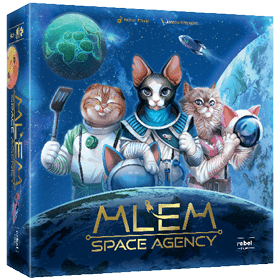MLEM: 우주 개척 기관
 MLEM: 우주 개척 기관에서는 우주 원정을 떠나는 사령관이 됩니다. 그렇지만 평범한 사령관이 아닙니다. 참여하는 우주비행사가 모두 고양이니까요!
MLEM: 우주 개척 기관에서는 우주 원정을 떠나는 사령관이 됩니다. 그렇지만 평범한 사령관이 아닙니다. 참여하는 우주비행사가 모두 고양이니까요!
앞으로 나아갈 때마다 주사위를 굴리면서, 미지의 영역으로 여행을 떠나 용감한 우주비행사와 함께 우주를 탐험해 보세요. 로켓에서 내려서 행성을 탐험하시겠나요, 모든 것을 걸고 더 멀리 발을 내딛어 보시겠나요?
MLEM: 우주 개척 기관에는 흥미로운 선택지와 손에 땀을 쥐는 운 시험 요소가 섞여 있습니다. 우주 고양이 테마와 라이너 크니지아 특유의 전략성이 합쳐져 긴장감, 경쟁, 그리고 웃음을 자아냅니다.
플레이어 수: 2 - 5
게임 시간: 25 mn
복잡성: 3 / 5
MLEM: 우주 개척 기관 및 다른 게임 1184개를 온라인으로 즐겨보세요.
다운로드가 필요없으며, 웹 브라우저에서 바로 플레이할 수 있습니다.
친구들과 그리고 전세계의 수많은 게이머들과.
무료.

MLEM: 우주 개척 기관 및 다른 게임 1184개를 온라인으로 즐겨보세요.
다운로드가 필요없으며, 웹 브라우저에서 바로 플레이할 수 있습니다.
친구들과 그리고 전세계의 수많은 게이머들과.
무료.

규칙 요약
Overview
Explore space, but make a mark for yourself before you crash!
Takeoff Phase
Each round starts with a Takeoff Phase.
During this phase, each player chooses an astronaut to send on the expedition.
Each astronaut grants the player a special effect, so choose wisely!
The lead astronaut (Starting Player) is the Commander.
Travel Phase
The commander of the expedition rolls all dice. The dice have six faces: 1, 2, 2, 3, 4, and afterburner. After they have been rolled, arrange the dice into groups of the same number (e.g. all the 2s).
The commander then picks any number of groups whose faces match the rocket marker's current location. For example, at location zero, afterburners, ones, and twos can be used. Threes and fours cannot be used when the rocket is at this location.
Each set chosen for movement is added up in its entirety (For example, a set of three 2s has a movement value of 6). The afterburner value is determined by the number of pips on the afterburner symbol at the location.
After moving, keep all afterburner dice and unused dice. Discard the rest. If this would result in having no dice left, keep a single die in the pool.
Crashing
After rolling the dice, if none of them match the allowed dice at the location, a Crash occurs!
The Cosmic Failure marker moves on one space.
Any astronaut with a parachute MAY disembark (see Landing Phase); all other astronauts are returned to the respective player mats.
The Commander is changed to the next player in turn order.
The current Expedition ends and there is no Landing Phase.
Landing Phase
If the Travel phase was a success (did not result in a Crash), the Landing Phase occurs.
If the ship is on space 0-5, the landing phase is voided, and a new Travel phase occurs.
If the ship is on space 6+, in order of astronauts on the rocket, each player can choose to stay on the ship or disembark.
If you choose to disembark at a moon space, place your astronaut on the highest numbered moon linked to that space.
If the stop is a moon space and all moons are occupied, you cannot disembark. Each moon accommodates only a single astronaut.
If you choose to disembark at a planet space, there are no limitations to the number of astronauts or who controls them. However, the order in which astronauts arrived matters. They will be placed from top to bottom in order of arrival.
If the ship manages to reach the last space on the board (deep space), the Commander is placed on the Comet and all passengers are placed on the Galaxy (neither of these places have an occupancy limit).
If at any point the Commander disembarks (excluding Deep Space of course), the next astronaut in line takes over as the new Commander. Other astronauts move up a seat in the rocket.
Once the Landing Phase is finished, if there are still astronauts in the ship, then commence another Travel Phase.
If all Astronauts have disembarked and/or Crashed, the expedition comes to an end and a new one commences with a new Commander.
Goals
There are four unique goals available to claim as soon as a player meets their condition. Only one player can claim each goal, but a player can claim multiple goals if achieved. Each claimed goal gives 5 points.
- First player to place 4 astronauts on 4 different planets.
- First player to place 3 astronauts on 1 planet.
- First player to place 4 astronauts on 4 moons.
- First player to place 2 astronauts in deep space.
Game End
The game ends when either the Cosmic Failure track reaches 11 or when a single player has disembarked all 8 of their astronauts and the current Expedition has reached a natural conclusion.
Occupied moons give each player occupying them the points displayed on them.
The planets score based on most astronauts on the planet, 2nd most astronauts on the planet, and finally simply being present on the planet, according to the score values shown next to the planet. If multiple players have the same number of astronauts on a planet, ties are broken in order of which player landed there earliest.
Add the points for any Goals you achieved.
The player with the most points wins! If there's a tie, the victory is shared.


